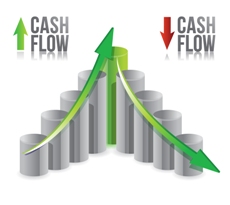
You would think that an increase in orders and growing interest in your business would be good news all round as it means that your company is expanding, but without the right amount of cash flow to support that growth, it could spell trouble.
There are plenty of examples of business owners who have not been able to survive their growing pains because of a lack of cash to support their expansion, so you need to plan for what lies ahead.
Here is a look at some ways to keep on top of cash flow. There are some tips on keeping your business and personal expenses away from each other, an insight on what cash flow actually means, and details on how to produce a cash flow statement to help stay on top of your money.
Separating your expenses
If you are one of the millions of small business owners who finds their personal finances intertwined with your business expenses, it is time to get things sorted so that you are well placed to take your business to the next level.
It is far too easy to blur the lines between personal and business expenses, but you need to keep on top of both and know exactly where your finances stand at any point in time.
Maintaining a separate personal and business account will help create that distinction. You could also consider getting a credit card for your business so that you can organize your expenses more easily and see where everything is going and how much you are spending.
Having your business and personal finances organized in this way will give you a better insight into your spending and allow you to avoid any unexpected cash flow issues.
Understanding what cash flow means
Keeping your finances separate is a good discipline to get into as your business grows but it is also essential to appreciate just what positive cash flow means to the survival of your venture.
In simple terms, a positive cash flow means your business is in a position where you have more cash coming in than going out. If you don’t achieve this positive balance with your business finances, the end result will be an inability to pay your employees and bills when you need to.
Cash flow management is not exactly a difficult concept to grasp, despite the fact that some business owners might feel intimidated by the subject. It simply describes a scenario where you are balancing income against expenses in your business.
What you mustn’t do is get confused between cash flow and profits, which are two very distinctly different things.
Cash flow describes the movement of money in and out of your business, and profit is the balance remaining after expenses have been deducted from your revenues.
Taking good care of the cash flow aspect of your business and keeping on top of your expenses will ultimately feed through to the bottom line, but without good cash flow, the subject of profitability could become an irrelevance.
The essentials
You should get used to preparing a cash flow statement on a weekly basis or even daily if you find that helps you keep on top of your finances more easily.
To create a cash flow statement you will need to work out exactly how much cash you currently have, an estimate of your cash receipts and goods sold, plus a list of your operating expenses.
Using this information you can then work out how much cash you have and expect to receive, and how much you will need to meet all of your commitments within the same time period.
Armed with that valuable data you can work out your cash flow and make plans around those figures, rather than wait to discover that there is a hole in your finances that you were not expecting.
Harvey Faulkner writes articles aimed at the self-employed or small business owner. He shares his top tips when it comes to money and taxes, as well as best practices and other subjects of interest. Check out SmallBusinessCreditcard if you’re seeking a credit card for your small business.






